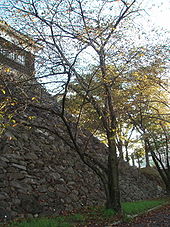.gif)
Kameyama Castle (Mie)
Encyclopedia

is a located in Kameyama
Kameyama, Mie
is a city located in Mie Prefecture, Japan.As of 2006, the city has an estimated population of 48,902 and the density of 256.15 persons per km². The total area is 190.91 km².The city was founded on October 1, 1954....
, Mie Prefecture
Mie Prefecture
is a prefecture of Japan which is part of the Kansai regions on Honshū island. The capital is the city of Tsu.- History :Until the Meiji Restoration, Mie prefecture was known as Ise Province and Iga Province....
, Japan
Japan
Japan is an island nation in East Asia. Located in the Pacific Ocean, it lies to the east of the Sea of Japan, China, North Korea, South Korea and Russia, stretching from the Sea of Okhotsk in the north to the East China Sea and Taiwan in the south...
. It was built in 1590 AD, by Okamoto Munenori, to replace the older Kameyama Castle, which had been built by Seki Sanetada in 1254.

History
Prior to the 17th century, the town surrounding the castle served as a castle townCastle town
A castle town is a settlement built adjacent to or surrounding a castle. Castle towns are common in Medieval Europe. Good example include small towns like Alnwick and Arundel, which are still dominated by their castles...
. With the construction of the Edo Five Routes
Edo Five Routes
The were the five major roads that started at Edo during the Edo period, the most important of which was the Tōkaidō, which linked Edo and Kyoto...
early in the Sengoku period
Sengoku period
The or Warring States period in Japanese history was a time of social upheaval, political intrigue, and nearly constant military conflict that lasted roughly from the middle of the 15th century to the beginning of the 17th century. The name "Sengoku" was adopted by Japanese historians in reference...
, the town became Kameyama-juku
Kameyama-juku
was the forty-sixth of the fifty-three stations of the Tōkaidō. It is located in the present-day city of Kameyama, in Mie Prefecture, Japan.-History:During the Edo period, Kameyama-juku served as both a post town and a castle town for Kameyama Castle...
, a post station
Shukuba
were post stations during the Edo period in Japan, generally located on one of the Edo Five Routes or one of its sub-routes. They were also called shukueki . These post stations were places where travelers could rest on their journey around the nation...
along the Tōkaidō
Tokaido (road)
The ' was the most important of the Five Routes of the Edo period, connecting Edo to Kyoto in Japan. Unlike the inland and less heavily travelled Nakasendō, the Tōkaidō travelled along the sea coast of eastern Honshū, hence the route's name....
.
In 1632, the tenshu (castle keep) was demolished. The base of the tenshu was occupied by the Tamonyagura
Yagura
Yagura is the Japanese word for "tower" or "turret." The word is most often seen in reference to structures within Japanese castle compounds, but can be used in a variety of other situations as well. The bandstand tower erected for Bon Festival is often called a yagura, as are similar structures...
, which was raised sometime between 1644 and 1648, when Honda Toshitsugu was lord of the castle. The Tamonyagura was declared a historic site by the prefectural government in 1953. In 1873, during the Meiji Restoration
Meiji Restoration
The , also known as the Meiji Ishin, Revolution, Reform or Renewal, was a chain of events that restored imperial rule to Japan in 1868...
, most of the castle was torn down.
At the present, only ruins of the 15-meter-high walls and the Tamonyagura remain, though the more recent Ōmoto-ji and the Kameyama City History Museum stand on the grounds.

